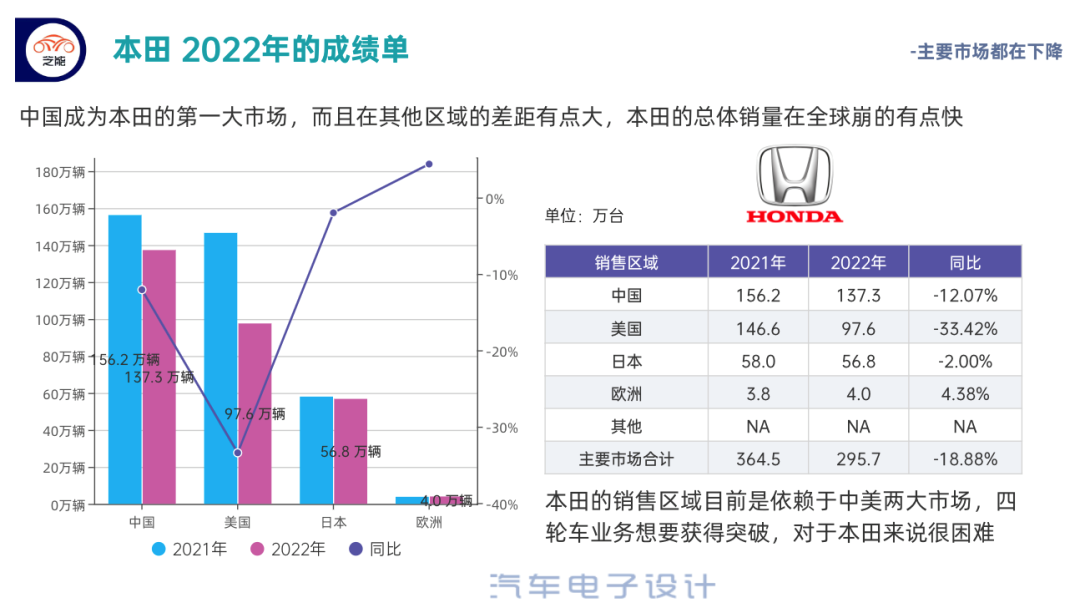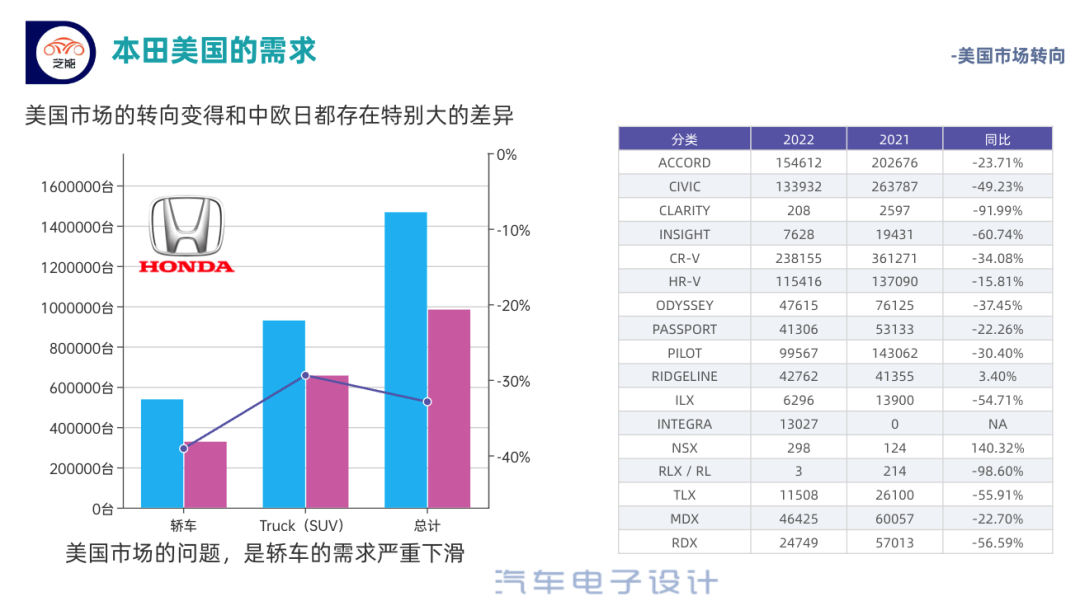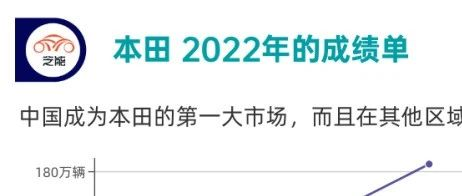Author: Tao Yanyan
The Top 10 electric vehicle transformation achievements of Zhineng Motors in 2022:
(1) Representative of radical transformation: Volkswagen
(2) Brand power overdraft: BMW
(3) More luxurious than luxury cars: Mercedes-Benz
(4) Diversified global sales champion: Toyota
(5) Challenger and Defender: Tesla
On the first day of work, I continued to take stock of the Honda Motor, which I had always considered a magical existence: the entire group’s business framework spans from two-wheeled vehicles, four-wheeled vehicles to aircraft businesses. Honda is very concerned about how to make money from its four-wheeled vehicle business. With limited investment and real challenges, Honda performed poorly in the global automotive market last year, with significant declines in its main markets-China and the United States, especially the U.S. market with less than one million vehicles.
◎ Chinese market sales of 1.373 million vehicles, a decrease of 12% year-on-year, and we will analyze the prospects of Japanese cars in the Chinese market separately in the future.
◎ Sales of 976,000 vehicles in the U.S., a 33.4% decline year-on-year, which can be described as a retreat, and the entire U.S. market has undergone a very fast transformation from sedans to SUVs and pickups.
◎ Sales of 568,000 vehicles in Japan, a 2% decline year-on-year. The demand in the Japanese car market really cannot increase due to factors such as population and economy.

Honda’s hybrid and electric vehicle strategy
China
Honda’s cumulative sales of electrified models in China in 2022 reached 231,274 units, but in fact, we have no concept of these vehicles. I have preliminarily pulled the data, as shown in Figure 2 below.
◎ BEV 17,700 units, mainly including eNS1, e:NP1 Jipai 1, Lingxuan VE-1, and Siming M-NV-These cars’ names are unfamiliar to domestic consumers, and if you are interested, we can study in detail why such a situation exists.
◎ PHEV 13,200 units, mainly including CRV Ryd-hybrid e+ and Haoying Ryd-hybrid e+. I think Honda can do PHEV well, but Japanese engineers are more inclined to HEV when compared to PHEV.◎ HEV is the highlight here, and Honda still relies on its reputation to continue its style in this field.

Honda’s next step is to expand the production and sales of its e:N electric vehicle models. From 2024 to 2030, Honda will purchase 123GWh of Ningde Times pure electric vehicle batteries (produced in Yichun, Ningde Times) in China. However, it is really difficult to say whether these cars can beat domestic automakers.
United States
As the Honda automobile market in the United States shrinks, the sales of electrified vehicles also decline. In 2021, the sales were 107,000 units, which fell to 96,600 units in 2022. Overall, due to the cooperation with General Motors, which will gradually increase in volume in 2024, Honda needs some time to make a move for the wave of pure electric vehicle development in the United States. Moreover, with the entry of major US automakers into the field of hybrid vehicles, it is difficult for Honda to maintain its advantage built upon the accumulation of hybrid car market.

Honda’s Multi-line Cooperation
This raises the discussion of Honda’s pure electric vehicle strategic cooperation:

Japan
Mainly cooperates with Sony to establish a joint venture company. Of course, this is to solve Honda’s intelligence issues, and Honda’s market share in Japan is only 500,000, which is difficult to develop and grow unless focusing on exploring small commercial electric vehicles.
United States
Cooperates with General Motors, and also needs to form a joint venture with LG. The outcome depends on whether General Motors makes progress. Therefore, the two companies are in an alliance state where they rise and fall together in the United States.
In China
Here, there are differences between the JV and the Japanese headquarters – Japanese technicians are not prepared for the Chinese market, which is so volatile.
When Honda management saw the problem, Japanese designers and developers were still confident in themselves. Three years of pandemic have left Japanese technicians with a lack of knowledge of Chinese car models. Just like when we talked about recommendations for Toyota’s future development yesterday: Honda should also look at the current Chinese car models, from development to planning, China is now at the forefront and it is worth learning from.
In addition, from the perspective of battery production, working with GM and LG’s joint venture can ensure a basic volume of 1 million cars for Honda in North America (calculated at 40GWh, this demand is approximately equivalent to 600,000 pure electric cars); cooperation with Ningde in China is also not a problem; while the deep development with GS in Japan is also for the next step. The future is also part of Honda’s future plans – overall, Honda has no problem cooperating with multiple partners in battery production, but it needs to speed up car sales in order to make use of this battery capacity.

————————
Summary: I personally think that Honda’s current development strategy is non-convergent, with a “preserve the past and open up the future” mentality. However, the strategy of pleasing both investors and senior executives with a “both-and-yet” attitude is a kind of vacillation, which ultimately leads to stagnation in the development of petrol and electric vehicles, which has a huge impact on Honda’s automotive business.
This article is a translation by ChatGPT of a Chinese report from 42HOW. If you have any questions about it, please email bd@42how.com.
